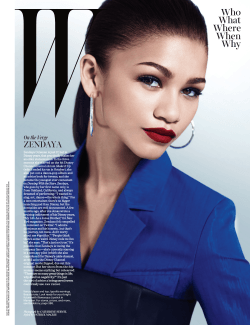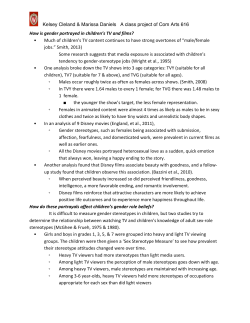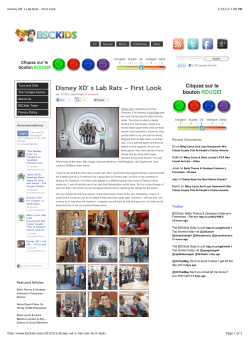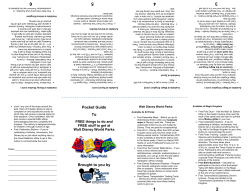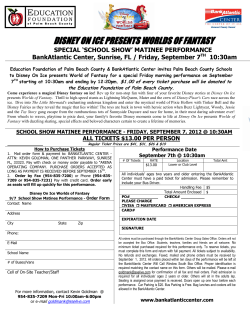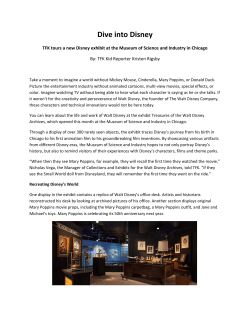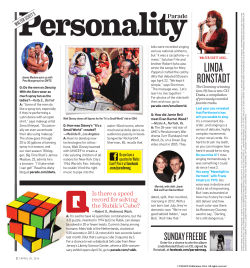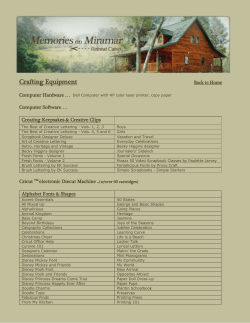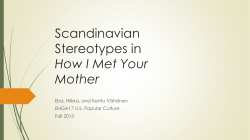
Stereotypes & Racism in Children’s Movies
Stereotypes & Racism in Children’s Movies by Libby Brunette, Claudette Mallory & Shannon Wood Racial awareness According to the National Association for the Education of Young Children (NAEYC), children between 2 and 5 years of age start to become aware of race, ethnicity, gender and disabilities. They can accurately identity “Black” and “White” when labeling pictures, dolls and people. Children develop their own racial identity during preschool and elementary school years (Ramsay, 2003). Children learn stereotypes and attitudes about race from their parents, caretakers and the world around them (Linn & Poussaint, 1999). That world includes books and various media images such as television and movies that children encounter on a regular basis. Stereotypes and racism in movies According to the Merriam Webster Collegiate Dictionary, racism is defined as “a belief that race is the primary determinant of human traits and capacities and that racial differences produce an inherent superiority of a particular race” (2005-2006). Stereotypes are preconceived or oversimplified generalizations usually, but not always, involving negative beliefs about a particular group. At a very young age, many children are exposed to movies, whether at the theater or on videos at home. One major producer of children’s movies is the Disney corporation. These animated films are often perceived as innocent and wholesome. “Given the influence the Disney ideology has on children, it is imperative for parents, teachers and other adults to understand how such films attract the attention and shape the values of the children who view and buy them (Giroux, 1995). There have been many instances of racism identified in Disney movies including The Jungle Book (1967) which portrays gorillas and orangutans that sound like black people and Oliver and Company, with a Chihuahua named Alonzo that is typecast as a Latino troublemaker. At one point in the film, he talks about stealing cars. This negative stereotype is what children may remember when they hear someone speak with a similar accent. Lady and the Tramp features the Siamese cats that negatively portray Asians. They clearly have stereotypical Asian features such as slanted eyes, buckteeth and very heavy accents and are depicted as sinister, cunning and manipulative (Sun, 2001). Some of the more current releases with racial stereotyping include Aladdin, the Lion King, Tarzan, and Pocahontas. “The Aladdin character in that movie portrays “bad” Arabs with thick foreign accents while Anglicized Jasmine and Aladdin speak in standard Americanized English” (Giroux, 1995). Aladdin looks and sounds like a fresh- faced American boy. One of the evil characters, Jafar, looks very Arabic. Some of the lyrics in the movie convey racist overtones: “I come from a land…where they cut off your ears if they don’t like your face. It’s barbaric, but hey, it’s home” (Maio, 1999). In The Lion King, the hyenas clearly speak in a kind of street, inner city African American dialect. They are considered the bad guys. Tarzan, which was released in 1999, is set in Africa but does not feature any black people. It is difficult to identify animated Disney movies with positive black role models. Another common stereotype noted in Disney movies is that of the Native American. In the film Peter Pan, Princess Tiger Lily’s father represents the negative stereotype of being uncivilized and savage as he holds Wendy’s brothers hostage. In Pocahontas, she represents the positive stereotype who respects the earth and communicates with the trees and animals (Reese, 1996). Although Pocahontas is portrayed in this more positive role, it still typifies a stereotype. Another major issue with this film is the historical inaccuracies it depicts. Pocahontas was a real woman, but very different from the Disney image. She was a child when she met John Smith and there was no romance between them (Maio, 1999). Teaching young children to resist bias It is evident that the Disney movies mentioned portray certain races and cultures in a negative manner. Children who view these movies without an informed adult explaining these inaccuracies may form ne gative biases and prejudices. In order to teach young children to resist these biases and to value differences, it is important for parents and teachers to present children with positive images. According to NAEYC, some examples of positive images include books, dolls, toys, wall decorations, and TV programs that show men and women in nontraditional roles and people of color in leadership positions. We can choose media images for children with positive images such as people with disabilities doing activities familiar to children, and a variety of family units. NAEYC also suggests other ways to counter negative stereotypes including talking positively about each child’s physical characteristics and cultural heritage. Help children learn the differences between feelings of superiority and those of self-esteem and pride in their own heritage. Provide opportunities for children to interact with other children who are racially/culturally different from themselves and with people who have various disabilities. Listen to and answer children’s questions about themselves and others. Don’t ignore, change the subject, or in any way make the child think she is bad for asking such a question. Help them to think critically about what they see in books, movies, greeting cards, comics, and on TV. Let children know that unjust things can be changed. For more information, please visit http://naeyc.org/ece/1997.asp Parents and educators can help children learn tolerance and acceptance of individuals from different races, cultures and ethnicities. We can start with small steps in our homes and in our classrooms to make a difference. Every step we take towards valuing diversity is a step in the right direction! References Giroux, H. (1995). Animating youth: the disnification of children’s culture. Retrieved March 21, 2006 from http://www.gseis.ucla.edu/courses/ed253a/Giroux/Giroux2.html Linn, S. & Poussaint, A., (1999). Watching television: What are children learning about race and ethnicity. Child Care Information Exchange, 128, 50-52. Maio, K. (1999) Women, race & culture in disney’s movies. Retrieved March 28, 2006 from http://www.newint.org/easier-english/Disney/diswomen-p.html Merriam-Webster Online. (2005-2006). Racism. Retrieved March 10, 2006 from http://www.m-w.com/dictionary/racism Ramsey, P. (2003) Growing up with the contradictions of race and class. In C. Copple (Ed.), A world of difference: Readings on teaching young children in a diverse society (pp.2428), Washington, D.C.: National Association for the Education of Young Children. Reese, D. (1996) Teaching young children about native americans, The clearinghouse on early education and parenting (ceep). Retrieved March 30, 2006 from http://ceep.crc.uiuc.edu/eecearchive/digests/1996/reese96.html Sun, C. (Producer), & Picker, M. (Director). (2001). Mickey mouse monopoly [Documentary]. (Available from Media Education Foundation, 60 Masonic Street, Northampton, MA 01060
© Copyright 2025
